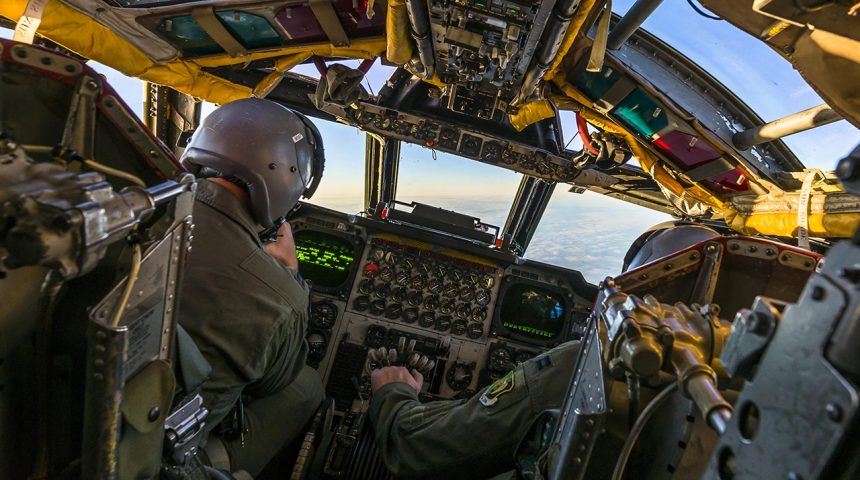An Italian on the BUFF at the USAF Test Pilot School. And how he did get there.
I was selected to join the Reparto Sperimentale Volo (RSV), the Italian Air Force Official Test Center (OTC) in late spring 1988. At that time I was a 27 years old lieutenant: a combat-ready fighter pilot of the 28° Gruppo (Squadron) “Streghe” (Italian for Witches) of the 3° Stormo (Wing), out of Villafranca Air Base, Italy. I was flying the old F-104G, the howling one, and having the time of my life.
I got the news that I had been chosen to join the prestigious RSV just few days before the tragic Frecce Tricolori’s incident in Ramstein.
I went through War College, in Florence, and then I was enrolled in the 311° Gruppo Volo of the RSV, the flying arm of the Italian OTC. I was based in Pratica di Mare AB, near Rome.
When someone joins this elite outfit he does so not being yet qualified as a test pilot. So the routine was, and still is, to spend about a year, give or take a few months, waiting for a slot at one of the Test Pilot Schools to which the RSV would send its newbies. At that time the Italian Air Force was sending its people to the United States, either to the USAF Test Pilot School, in Edwards AFB, California, or to the USNTPS, in Patuxent River. Two other possible destinations were in Europe: the École du Personnel Navigant d’Essays et de Réception (EPNER) in Istres, France, withe the Armée de l’Air, and the Empire TPS in Boscombe Down, with the Royal Air Force.

During that year I was, along with the two Academy classmates that had been selected with me, an “ascaro”: that was the nickname that was given to the new guys. From the last decade of the XIX century up to World War Two, the “ascari” were the colonial colored troops of the “Regio Esercito”, the Italian Royal Army. I guess it was a slightly derogatory title but, you know, it was a tradition and we, of course, went along with it. In general, in the Italian Air Force, the “ascari” were the pilots who had not attend the Air Force Academy. I guess that we were, for that one year, the only “zoomies” who were also “ascari”.
The good thing of being an “ascaro”, at the RSV, was that all you had to do was to fly as much as possible on all the aircraft that were available at the squadron. In 1989, we had about ten different aircraft, from fighters to heavy lifters, from trainers to prop light aircraft, and helicopters available for our training. It was a great advantage for us to be able to go to the schools with a wide range of experience on so many different aircraft. That would compensate for our generally younger age and fewer flying hours, compared to those of our future classmates.
In the early months of 1990, I was informed by my bosses that I would have been sent to the USAFTPS. “Good deal!” I thought: everyone wanted to go to Edwards!
I had, by then, just been promoted to captain.
I left for the USA in the spring of 1990 and headed first for a 9-week English course at the “Defense Language Institute”, in Lackland AFB, Texas. Vincenzo Pennetta, an Air Force engineer, was to also attend the USAFTPS with me, so we left together for this adventure.
In late June, Vincenzo and I drove all the way from San Antonio to the Mojave desert to start the USAFTPS second session of the year with class 90B.
Our class was of 25 members, all Americans but five: the yours truly with his pal; two Canadians (a pilot and an engineer as well), and a Navy RIO (Radar Intercept Officer), an F-14 back seater, who, even if born and raised in the U.S., was considered, to all intents and purposes, a foreigner.
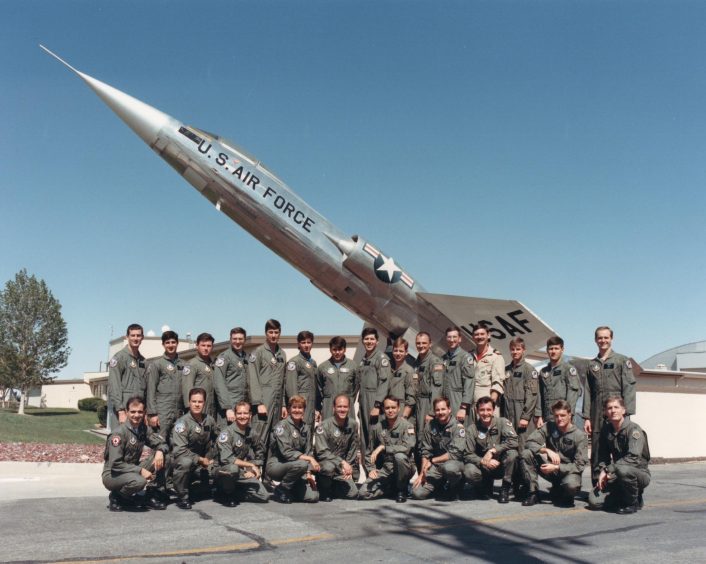
The course was divided in four phases: performances, flying qualities, systems and testing. In each phase you had to fly, to attend academics classes and, the most difficult part for us Italians, to write reports.
The school curriculum aircraft were the T-38 Talon, the F-4 Phantom, in the RF-4C and F-4E versions, the A-7 Corsair, the “D” and the “K”, the F-16A Fighting Falcon. Those were the airplanes where we would be rated as solo pilots. The engine-out program was carried out on the DHC-6 Twin Otter, while the spin and departure program was based on gliders, on the A-37 Dragonfly and on the A-7D.
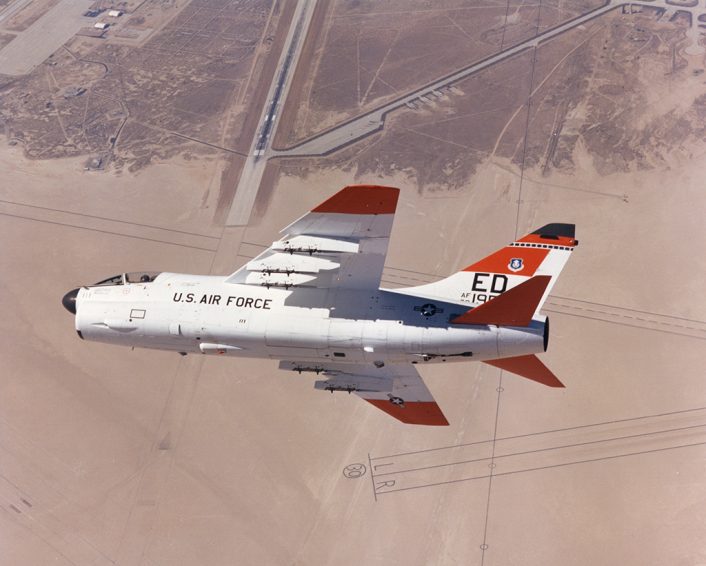
I went through “Performances” on the T-38 and “Flying Qualities” on F-4.
In the “Systems” phase we would start to fly on different types of aircraft evaluating single systems as radar, inertial platform, infrared, air-to-air refueling, head-up display and so on.
In the “Testing” phase we would get a “real world” test, and that would also be our final exercise, our final test, if you want. We would also fly various aircraft, learning to evaluate them for certain specific roles. Those flights were called “Quality Evaluation”, “QualEval” in short. You would get, for instance, an F-18 (as I did) for one or more flight to evaluate it in a qualitative way (no data were required) for the air-to-ground role. You would built a test plan based on one or more flights, decide what you would like to see, fly the thing and then write a report based on your qualitative evaluation of the aircraft. It was FUN!
My class, though, had one problem to deal with: the desert. Not the Mojave one, but the “Shield” and the “Storm” deserts. That’s right, the first Gulf War. There weren’t simply a lot of aircraft around to be flown by us students. Basically, everyone was down in the Middle East doing their things.
Still, we did get some to work with and so one day I was called by one of the school’s staff members and I was told that I would get a single sortie on a B-52 Stratofortress.
Now, the B-52 (aka the BUFF, Big Ugly Fat Fucker, or Fellow, in the more polite official version) was, and still is, a myth: an aircraft with 8 engines and wheels on the wingtips, a Vietnam veteran that was about to go to war in the Middle East some 20 years later; a huge beast with bomb bays and bomb doors like the old vintage World War II’s bombers. I just couldn’t wait to be airborne with that myth strapped on my back. I also wondered about how many Italian pilots had ever laid their hands on such an aircraft: not many, if any, I figured out, and that added great pride for what I was about to accomplish.
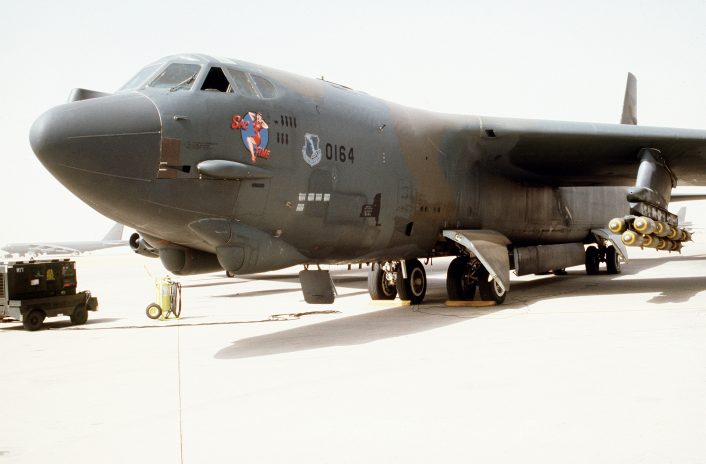
I was asked to qualitatively evaluate the BUFF for the low level day/night penetration role.
I laid out a test plan, prepared my test card, and then I sat down with the IP (we would, of course, always fly with an Instructor Pilot) and told him what I wanted to do and what I wanted to see. We would, of course, always clear our plans with the IP just to be sure that we were not going to do anything particularly dumb during our flight.
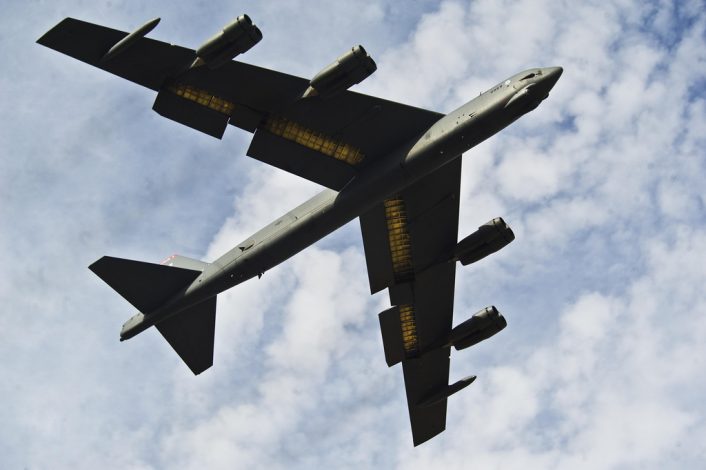
What I asked for was a low level navigation using whatever system was available on board (Inertial Navigation, Forward Looking InfraRed or FLIR, Terrain Following… the lot) and I also asked for an AAR (Air to Air Refuel). I wanted an “high gain” task to properly evaluate the handling characteristics of the BUFF. A “high gain” task such as AAR, or a gun tracking exercise, is always required to evaluate the flying qualities of an aircraft. Sometimes you would find that a perfectly nice flying aircraft in a “low gain” task (i.e. a gentle turn or some aerobatics) would turn in a nightmare when used more aggressively.
I was lucky: we got an AAR slot with an ANG KC-135.
Test plan approved by the IP and by the TPS, our AAR slot coordinated, we were ready to fly.
The aircraft was huge; the tiny wheels at the wingtips looked incongruous with the size of the wing. The landing gear layout was funny, with its two bicycle-like front and rear struts: I knew that it was possible to hydraulically move the main landing gear to crab into the wind maintaining the wheels aligned to the runway: I really wanted to see that.
Access to the cockpit was directly below it: through an hatch you would literally climb to the cockpit area; it really looked like climbing to the con tower of a submarine.
The cockpit itself was quite cramped: you had to strap in, fighter-like, to an ejection seat (nice to have) and wear an helmet and oxygen mask. I actually used the very same helmet I wear on the F-4. But no control stick: you had a yoke that was really proportioned to the size of the beast: it was wide as my forearm (hand included)! I was really worried about handling that one: I couldn’t avoid to notice the size of my IP’s biceps. I heard stories about the B-24 Liberator’s pilots arms size and I thought that we could have a bit of the same situation here. Thinking about it, I realized that my only B-52’s pilot classmate had the look of a body builder…
The instrument panel was cramped with dials and knobs: eight columns of engine instruments right in the middle of the panel was a mesmerizing sight; but, row by row, they were all perfectly at the same position, so it would have been quite easy to spot one single dial out of the “normal operation” range.
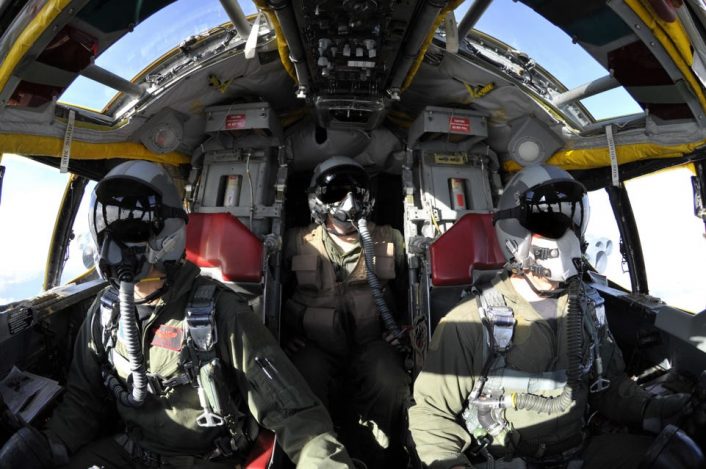
The throttles (EIGHT!) panel looked like an old style typewriter: eight throttle levers crowning the central pedestal, each one then protruding a single disk toward the center, so you could grab all eight of them with an hand and move all the throttles at the same time. Big biceps would also be very helpful here.
A real man’s aircraft!
Engines start sequence was fast and taxing the aircraft was fun: you had this big turn knob on the central pedestal that, if turned one way or the other, would hydraulically rotate the forward and back main gear strut in such a way that you could “crab” the aircraft keeping the wheels straight down the taxiway and taxi looking through the side windows. The reason to have such a system was to allow the BUFF to takeoff and land in a crosswind condition: due to the very low clearance of the wingtip from the ground (notwithstanding the wingtip gear) the cross-controls technique was not possible and so you had to takeoff and land using the “crab” technique, which means keeping the wing level and pointing the nose into the wind. With a bicycle landing gear system that would cause a great sideway stress on the gear structure, so Fairchild thought of an hydraulically operated system that would keep the wheels aligned with the runway even if the body of the aircraft was turned, say, 20 degrees off to the left or to the right. In very strong crosswind you actually landed the BUFF looking through the side window!

During the takeoff roll you had a liftoff of the wingtip gears lot earlier that the main gear: you actually could see the wing moving up with all the engines way before main body liftoff. The aircraft would also not rotate in the classical way but it would rather go airborne on both forward and rear main gear at the same time: a rather characteristic “lift” takeoff. It really felt like you were sitting in the up-going lift of a building.
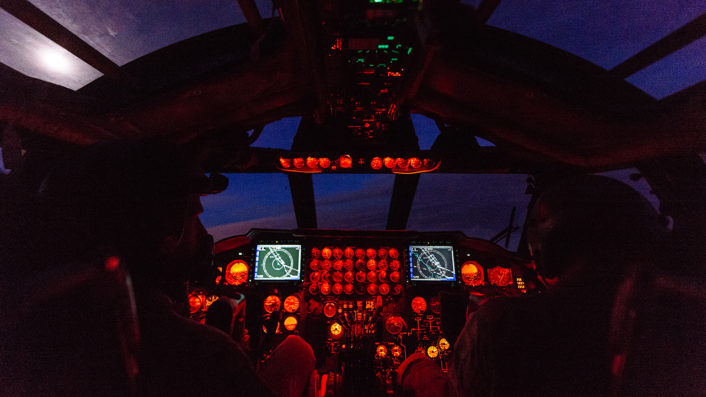
We flew a low level route and I remember that the BUFF had a very good navigation system and an excellent FLIR for night flying. Impressive was the wing “flapping” while flying low level and in light turbulence conditions. I think that the wing tips had a vertical excursion of at least a couple of feet. Looking at those 4 engines (per side) flapping along the wings really scared the living shit out of me.
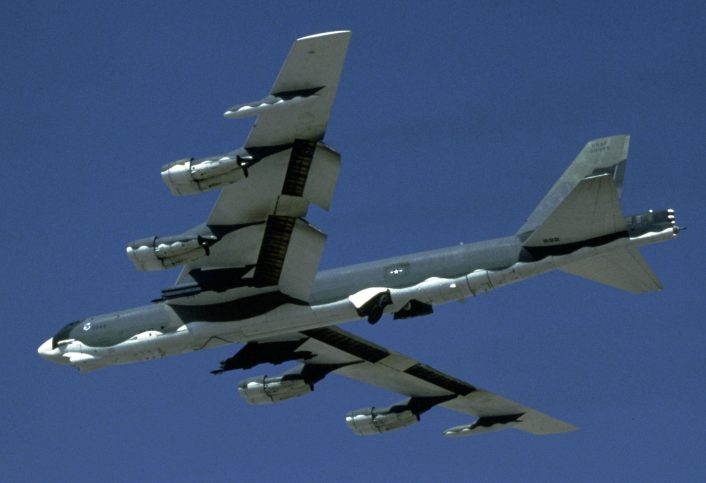
Flying the B-52 required a great deal of strength and patience: such a big aircraft was sluggish in response (roll delay was very noticeable) and yoke inputs required a lot of force. This became even more apparent when we got to the tanker. During this “high gain” task, yoke inputs were very frequent and quite ample, mainly in roll, and they required a great deal of anticipation because of the delayed response of the BUFF to any control input. I saw my IP shoving the yoke (and the throttles) around a great deal without me noticing any effect on the aircraft response. But, when I tried, I was able to get a nice contact with the boom but I was not able to maintain refueling position for more than 30 seconds.
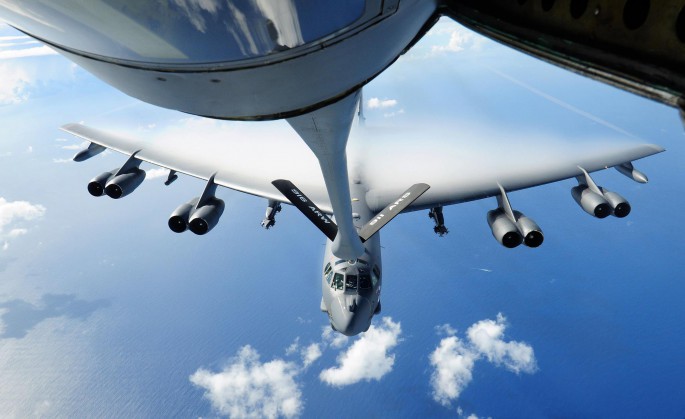
My control inputs were probably too slow and too late to maintain the correct position under the tanker and I started oscillating from side to side probably scaring to death the boom operator that would invariably retract the boom and send me away to try another time. You have to remember that we were bigger than the tanker itself (and we are talking of a B-707 sized aircraft here…)!
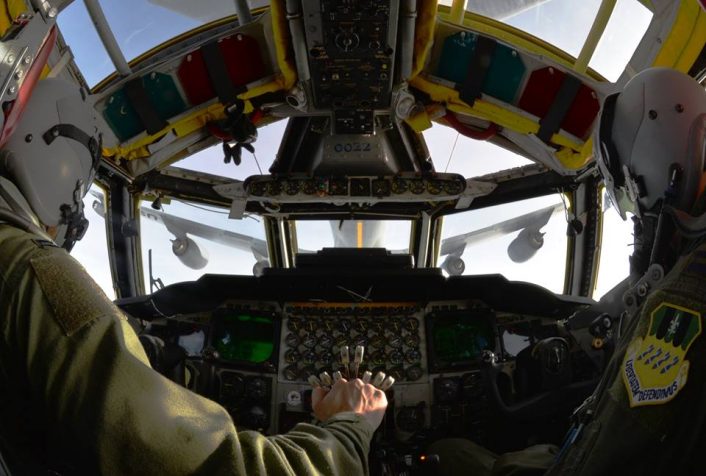
I already knew, by that time, that “pilot compensation” and training could overcome almost any flight control problems, but this was sure a “live” confirmation of that.
We came back for landing after maybe 3 hours of flight and practiced few touch and goes. I already talked about the landing “crab” technique in crosswind conditions. You would not really flare the BUFF a great deal for landing: you rather put it on the ground almost touching simultaneously on both the forward and aft main gear, but I really did not found it too difficult to do.
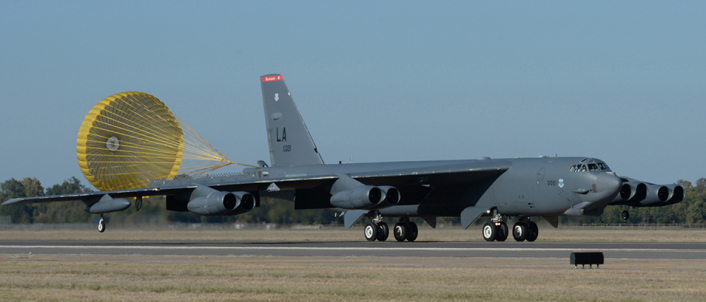
After the flight , I filled up few handwritten pages for my “qualeval” report and I guess it did not raise too many eyebrows because I cannot recall any particular criticism about it.
And that was it!
I had many flights like this one and I had oh so much fun! It was, undoubtedly, the best part of the USAFTPS curriculum. I graduated in June 1991 (a Distinguished Graduate, no less) and went back to the RSV to join the Eurofighter Test Team. Well, I was not an “ascaro” anymore!

